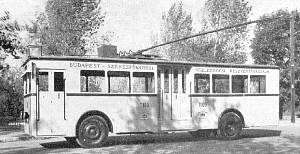 |
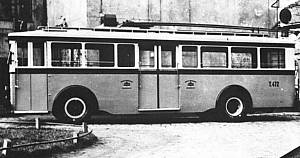 |
|
|
|
|
|
Trolleybuses of Óbuda |
 |
 |
|
|
|
The autobus traffic of Budapest started to evolve in the '20s of the XX. century. These years the most important aspect was to complete the tram network, especially at areas without tram service. Also the intent of the BSzKRt. (Budapest Capitol Transportation Company - the tram company) was that the bus lines should "train" the passengers to use public transportation where a tramway line later is proposed. Partially this was the reason of building the first trolleybus line in Budapest: here earlier - before the Great War - was a tramline planned to the cemetery of Óbuda (this is the at the northern part of Buda side of the city - Altofen was its German name). Since the passenger number was expected low, this peripherical route was ideal to try the new method of transportation.Some frames from the news-film at this time:The trolleybus service in large was emerging from the U.K. after Wold War I. These years it had indisputable advantage against the slowly progressing autobus-technology. Before the introduction of diesel-buses it was cheaper to operate a trolleybus line besides its more comfortable service.
The first trolleybus line in Budapest was opened on 16th December 1933 between the Vörösvári út (street) tramway line and the cemetery of Óbuda. At first it beared the line number 7, later (before 1936) this was changed to T. A small depot was furnished for the fleet at Óbuda tram-depot (that situated at the terminus). The line was earlier operated by SzAÜ (Capitol Autobus Service) since 5th June 1927: that is where the line number is comming from.
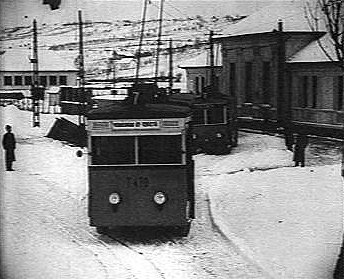 |
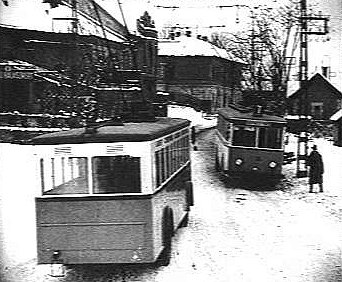 |
|
|
|
Three trolleybuses were purchased for the opening of the line: two from the Hungarian factory Ganz, and a single one is from the Hungarian factory MÁVAG (the State Railway's Factory) with Swiss Brown-Boveri electric equippment.The Ganz-trolleybus prototype was ready before the opening of the line, this time it obtained T100 number. This has been modified for the first day of service, and the cars were put in the numbering scheme of the autobuses with number T470. The second Ganz car had the number T471 probably from the beginning.
The trolleybus of MÁVAG originally was T.472, but it was also modified to T.480 (and again to T480).
The BSzKRt. buyed actually the three vehicles in 1934.
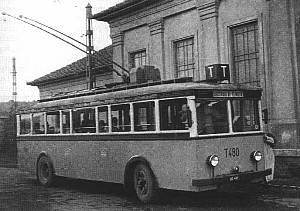
The T480 with already line name T, at the terminus of Óbuda cemetery. |
The steel-framed trolleybuses had very charateristic boxy shape.
Their full speed was around 30-40 km/h, but because of the rigid cable
attachment speed limits were ordered at road-faults preventing the
derailments of the trolley. At first only a red light was signalling
the derailment, but soon a buzzer was installed too. A separate lamp
was signalling if the trolleybus was about to go away too much from the
wires.
According to the regulations the vehicles were equipped with headlights (operated from accumulator), waving arms for signalling turns, and licence plates. Comparing the shade of the black and white pictures, the trolleybuses had the standard BSzKRt. yellow-brown liveries. |
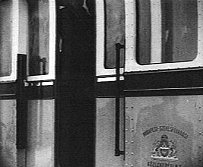 Automatic telescopic doors in the Boveri-trolleybus. |
The Boveri trolleybus was the first in Budapest, that had an
automaic door. Possibly only the middle one was operated by compressed
air. On the Ganz vehicles, the middle doors were operated by hand.
Presumably the first door was operated by the driver: since he was
sitting, the door was likely to be operated through a handle-mechanism.
On the Boveri vehicle even a heating system was installed. |
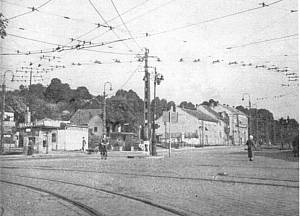
The terminus at Vörösvári út. There is no turnout to the depot on the poles, the tram crossing is also built without any need of isulation. These kind of "profile-crossings" had by nowdays died out in Budapest. |
The 2.7 km long line was quite simple: there
was a single loop on both ends. There was no turnout, insulation, wire
crossing along the line (even it seems, that there was no dead wire
point at all!). During the weekdays one or two cars were in service, on
Sundays all three were in the traffic. The time of the run lasted 8
minutes.
The line was built with rigid cable attachment, later in the city lines this system was not applied. Originally the cars had roller-trolley, but these were not standing long: the roller was burned by the current ran through. Later they changed them to sliding trolleys with iron insertion, that was lubricated with oil. |
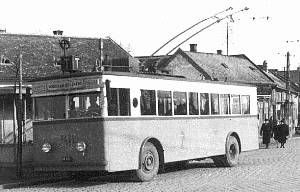
The T471 Ganz-trolleybus after rebuilding to righthandside driving. On the front the licence plate is visible:BX 471. |
Between 9th September and 9th November in 1941 the three
trolleybuses were rebulilt to the righthandside driving. During this
time autobuses were in service.
The end of the history of the Óbuda line was on 21st September 1944, when during an air raid the cables were seriously damaged. For a replacement autobuses were running on line T again until 24th December. The three trolleybuses were stored without use. |
 On this bad quality picture the first brigade of trolleybus drivers, an MTB learner-car and the Boveri trolleybus are visible. |
After May 1949 - before opening the line 70 in the city centre -
the preparation of the drivers for the MTB
type started in the Városliget (City-park) with the three Óbuda cars.
After the T470-T471 and the T480 was used as
a learner-car. Possibly with the recovering of the three trolleybuses
they were repainted to dark red.
Because of the growing traffic, from 31st August 1953 the three trolleybuses were back in the passanger service. But not for long: until 1955. |
The T470 was scrapped in January 1955, and the T471, T480 was in December 1955. After they used the body of the cars for a shack painted grey (e.g. one at the terminus of Keleti pályaudvar - Eastern Railway Station).
|
|
|
|
|
|
|
|
|
| ||
|
|
|
|
|
|
|
|
A speciality of the three Óbuda trolleybuses was the protection against the leaking current. Leaking current is possible on every electric vehicles at faulty insulations, dirty electric parts. While it means no problem on vehicles on rail (since the body of the car is always grounded), on trolleybuses the ascending passanger could be the one, who makes the connection to the ground: giving him an electric shock.On both Óbuda types the body of the trolleybus was connected to the negative pole (directly on the Boveri, through a cuprox rectifier on the Ganz cars). There is a problem with this method: the negative pole should be perfectly grounded. This was probably the case on the Óbuda line, but it was - as far as I know - not the case in the inner city lines built in the '50s. Thus 50V in the negative pole is not extraordinary (especially when it is far from the converter machine). Today this technology is not allowed: instead of grounding the body of the trolleybus, from the MTB type a double insulation is used.